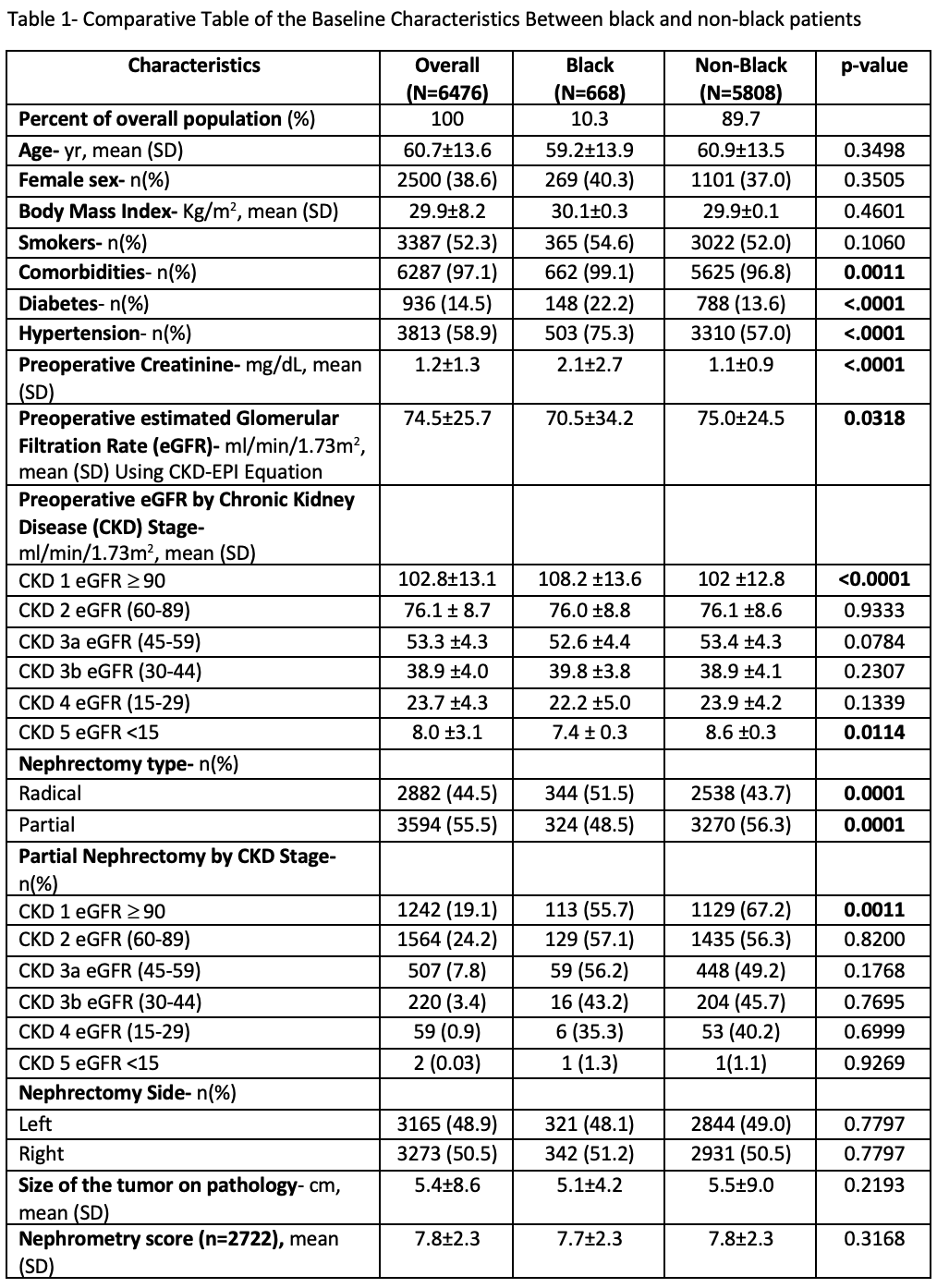Back
Poster, Podium & Video Sessions
Best Poster Award
MP24: Kidney Cancer: Localized: Surgical Therapy I
MP24-01: Race Based Equations for Estimating Kidney Function May Contribute to Racial Disparities in Partial Nephrectomy Utilization among Black Patients with Kidney Tumors
Saturday, May 14, 2022
8:45 AM – 10:00 AM
Location: Room 222
Nour Abdallah*, Tarik Benidir, Martin Hofmann, Eiftu Haile, Diego Aguilar Palacios, Venkatesh Krishnamurthi, Samuel Haywood, Mohamed Eltemamy, Jihad Kaouk, Robert Abouassaly, Steven Campbell, Christopher Weight, Cleveland , OH

Nour Abdallah, MD
Cleveland Clinic Foundation
Poster Presenter(s)
Introduction: Population based studies have found that black Americans with renal tumors are less likely to undergo a partial nephrectomy (PN) compared to non-black Americans despite their increased risk for chronic kidney disease (CKD). Guidelines suggest assessment of renal function, tumor size and location to determine whether to perform a PN or radical nephrectomy (RN). However, commonly used equations to predict renal function are racialized and estimate a 15-20% higher glomerular filtration rate (eGFR) if the patient is black compared to non-black patients. We hypothesize that these racialized estimates of eGFR may contribute to the lower utilization of PN in blacks.
Methods: From 2005 to 2020, we included 6476 consecutive patients undergoing either PN or RN with known self-reported race and preoperative (preop) creatinine at Cleveland Clinic. Data was dichotomized into Black (n=668) and non-Black patients (n=5808) and compared across preop variables and surgery types. Multivariable regression analysis was used to identify predictors of PN. We also stratified PN rates across CKD stages for blacks and non-blacks.
Results: The cohorts’ preop variables are listed in Table 1. Black patients had higher rates of diabetes, hypertension, had higher comorbidity scores and lower baseline eGFR. On multivariable logistic regression analysis, black patients were less likely to be treated via PN (Odds Ratio (OR) =0.75, Confidence interval (CI) = [0.63-0.89], p=0.001), even when controlling for body mass index, age-adjusted Charlson comorbidity index, hypertension, preop eGFR, tumor size and complexity. When comparing PN rates across CKD stages, PN utilization was similar for all stages except stage 1, where the odds of getting a PN were 39% lower for black patients compared to non-blacks (OR 0.61, [0.46-0.82], p=0.01).
Conclusions: Black patients were less likely to undergo PN, despite lower baseline kidney function and higher comorbidity rates. This disparity was most marked in patients with high estimated renal function. Racialized kidney function equations may contribute, along with access and other unknown factors to the disparity seen in the use of kidney preservation strategies for black patients with renal masses.
Source of Funding: None

Methods: From 2005 to 2020, we included 6476 consecutive patients undergoing either PN or RN with known self-reported race and preoperative (preop) creatinine at Cleveland Clinic. Data was dichotomized into Black (n=668) and non-Black patients (n=5808) and compared across preop variables and surgery types. Multivariable regression analysis was used to identify predictors of PN. We also stratified PN rates across CKD stages for blacks and non-blacks.
Results: The cohorts’ preop variables are listed in Table 1. Black patients had higher rates of diabetes, hypertension, had higher comorbidity scores and lower baseline eGFR. On multivariable logistic regression analysis, black patients were less likely to be treated via PN (Odds Ratio (OR) =0.75, Confidence interval (CI) = [0.63-0.89], p=0.001), even when controlling for body mass index, age-adjusted Charlson comorbidity index, hypertension, preop eGFR, tumor size and complexity. When comparing PN rates across CKD stages, PN utilization was similar for all stages except stage 1, where the odds of getting a PN were 39% lower for black patients compared to non-blacks (OR 0.61, [0.46-0.82], p=0.01).
Conclusions: Black patients were less likely to undergo PN, despite lower baseline kidney function and higher comorbidity rates. This disparity was most marked in patients with high estimated renal function. Racialized kidney function equations may contribute, along with access and other unknown factors to the disparity seen in the use of kidney preservation strategies for black patients with renal masses.
Source of Funding: None


.jpg)
.jpg)